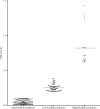Biofilm production by Candida species and inadequate antifungal therapy as predictors of mortality for patients with candidemia
- PMID: 17460052
- PMCID: PMC1933062
- DOI: 10.1128/JCM.00131-07
Biofilm production by Candida species and inadequate antifungal therapy as predictors of mortality for patients with candidemia
Abstract
Nosocomial Candida bloodstream infections rank among infections with highest mortality rates. A retrospective cohort analysis was conducted at Catholic University Hospital to estimate the risk factors for mortality of patients with candidemia. We reviewed records for patients with a Candida bloodstream infection over a 5-year period (January 2000 through December 2004). Two hundred ninety-four patients (42.1% male; mean age +/- standard deviation, 65 +/- 12 years) were studied. Patients most commonly were admitted with a surgical diagnosis (162 patients [55.1%]), had a central venous catheter (213 [72.4%]), cancer (118 [40.1%]), or diabetes (58 [19.7%]). One hundred fifty-four (52.3%) patients died within 30 days. Of 294 patients, 168 (57.1%) were infected by Candida albicans, 64 (21.7%) by Candida parapsilosis, 28 (9.5%) by Candida tropicalis, and 26 (8.8%) by Candida glabrata. When fungal isolates were tested for biofilm formation capacity, biofilm production was most commonly observed for isolates of C. tropicalis (20 of 28 patients [71.4%]), followed by C. glabrata (6 of 26 [23.1%]), C. albicans (38 of 168 [22.6%]), and C. parapsilosis (14 of 64 [21.8%]). Multivariable analysis identified inadequate antifungal therapy (odds ratio [OR], 2.35; 95% confidence interval [95% CI], 1.09 to 5.10; P = 0.03), infection with overall biofilm-forming Candida species (OR, 2.33; 95% CI, 1.26 to 4.30; P = 0.007), and Acute Physiology and Chronic Health Evaluation III scores (OR, 1.03; 95% CI, 1.01 to 1.15; P < 0.001) as independent predictors of mortality. Notably, if mortality was analyzed according to the different biofilm-forming Candida species studied, only infections caused by C. albicans (P < 0.001) and C. parapsilosis (P = 0.003) correlated with increased mortality. Together with well-established factors, Candida biofilm production was therefore shown to be associated with greater mortality of patients with candidemia, probably by preventing complete organism eradication from the blood.
Figures



Similar articles
-
Epidemiology and predictors of mortality in cases of Candida bloodstream infection: results from population-based surveillance, barcelona, Spain, from 2002 to 2003.J Clin Microbiol. 2005 Apr;43(4):1829-35. doi: 10.1128/JCM.43.4.1829-1835.2005. J Clin Microbiol. 2005. PMID: 15815004 Free PMC article.
-
Epidemiology of candidaemia and antifungal susceptibility patterns in an Italian tertiary-care hospital.Clin Microbiol Infect. 2006 Jan;12(1):75-80. doi: 10.1111/j.1469-0691.2005.01310.x. Clin Microbiol Infect. 2006. PMID: 16460550
-
Epidemiology of candidemia at a Children's hospital, 2002 to 2006.Pediatr Infect Dis J. 2009 Sep;28(9):806-9. doi: 10.1097/INF.0b013e3181a0d78d. Pediatr Infect Dis J. 2009. PMID: 19636286
-
Candida and candidaemia. Susceptibility and epidemiology.Dan Med J. 2013 Nov;60(11):B4698. Dan Med J. 2013. PMID: 24192246 Review.
-
Polymicrobial candidemia.Diagn Microbiol Infect Dis. 2002 Dec;44(4):353-7. doi: 10.1016/s0732-8893(02)00460-1. Diagn Microbiol Infect Dis. 2002. PMID: 12543540 Review.
Cited by
-
Genotypic and phenotypic properties of Candida parapsilosis sensu strictu strains isolated from different geographic regions and body sites.BMC Microbiol. 2010 Jul 28;10:203. doi: 10.1186/1471-2180-10-203. BMC Microbiol. 2010. PMID: 20667137 Free PMC article.
-
Biofilms formed by Candida albicans bloodstream isolates display phenotypic and transcriptional heterogeneity that are associated with resistance and pathogenicity.BMC Microbiol. 2014 Jul 5;14:182. doi: 10.1186/1471-2180-14-182. BMC Microbiol. 2014. PMID: 24996549 Free PMC article.
-
The Evaluation of the virulence factors of clinical Candida isolates and the anti-biofilm activity of Elettaria cardamomum against multi-drug resistant Candida albicans.Curr Med Mycol. 2016 Jun;2(2):8-15. doi: 10.18869/acadpub.cmm.2.2.3. Curr Med Mycol. 2016. PMID: 28681014 Free PMC article.
-
Outbreak of candidemia caused by fluconazole resistant Candida parapsilosis strains in an intensive care unit.BMC Infect Dis. 2016 Aug 20;16(1):433. doi: 10.1186/s12879-016-1767-9. BMC Infect Dis. 2016. PMID: 27544427 Free PMC article.
-
Evaluation of capacity to detect ability to form biofilm in Candida parapsilosis sensu stricto strains by MALDI-TOF MS.Folia Microbiol (Praha). 2016 Nov;61(6):465-471. doi: 10.1007/s12223-016-0458-7. Epub 2016 Apr 11. Folia Microbiol (Praha). 2016. PMID: 27068413
References
-
- Almirante, B., D. Rodriguez, B. J. Park, M. Cuenca-Estrella, A. M. Planes, M. Almela, J. Mensa, F. Sanchez, J. Ayats, M. Gimenez, P. Saballs, S. K. Fridkin, J. Morgan, J. L. Rodriguez-Tudela, D. W. Warnock, A. Pahissa, and the Barcelona Candidemia Project Study Group. 2005. Epidemiology and predictors of mortality in cases of Candida bloodstream infection: results from population-based surveillance, Barcelona, Spain, from 2002 to 2003. J. Clin. Microbiol. 43:1829-1835. - PMC - PubMed
-
- Cheng, J. R., L. C. Lin, T. G. Young, C. E. Liu, C. H. Chen, and R. W. Tsay. 2006. Risk factors for candidemia-related mortality at a medical center in central Taiwan. J. Microbiol. Immunol. Infect. 39:155-161. - PubMed
-
- Douglas, L. J. 2003. Candida biofilms and their role in infection. Trends Microbiol. 11:30-36. - PubMed
-
- Eggimann, P., J. Garbino, and D. Pittet. 2003. Epidemiology of Candida species infections in critically ill non-immunosuppressed patients. Lancet Infect. Dis. 3:685-702. - PubMed
-
- Friedman, N. D., K. S. Kaye, J. E. Stout, S. A. McGarry, S. L. Trivette, J. P. Briggs, W. Lamm, C. Clark, J. MacFarquhar, A. L. Walton, L. B. Reller, and D. J. Sexton. 2002. Health-care associated bloodstream infections in adults: a reason to change the accepted definition of community-acquired infections. Ann. Intern. Med. 137:791-797. - PubMed
Publication types
MeSH terms
Substances
LinkOut - more resources
Full Text Sources

